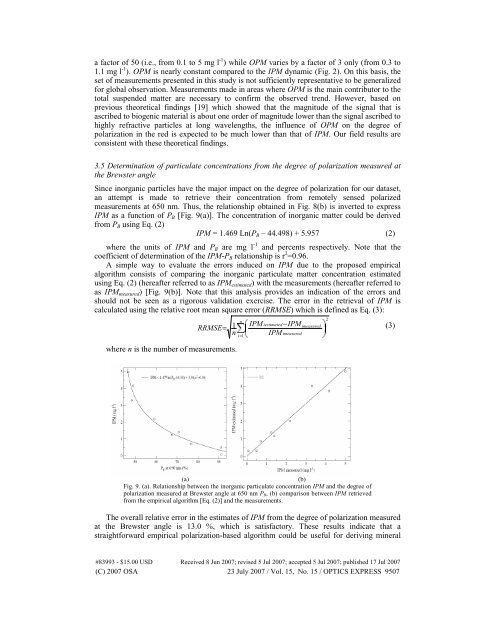Determination of biogeochemical properties of marine particles ...
Determination of biogeochemical properties of marine particles ...
Determination of biogeochemical properties of marine particles ...
Create successful ePaper yourself
Turn your PDF publications into a flip-book with our unique Google optimized e-Paper software.
a factor <strong>of</strong> 50 (i.e., from 0.1 to 5 mg l -1 ) while OPM varies by a factor <strong>of</strong> 3 only (from 0.3 to<br />
1.1 mg l -1 ). OPM is nearly constant compared to the IPM dynamic (Fig. 2). On this basis, the<br />
set <strong>of</strong> measurements presented in this study is not sufficiently representative to be generalized<br />
for global observation. Measurements made in areas where OPM is the main contributor to the<br />
total suspended matter are necessary to confirm the observed trend. However, based on<br />
previous theoretical findings [19] which showed that the magnitude <strong>of</strong> the signal that is<br />
ascribed to biogenic material is about one order <strong>of</strong> magnitude lower than the signal ascribed to<br />
highly refractive <strong>particles</strong> at long wavelengths, the influence <strong>of</strong> OPM on the degree <strong>of</strong><br />
polarization in the red is expected to be much lower than that <strong>of</strong> IPM. Our field results are<br />
consistent with these theoretical findings.<br />
3.5 <strong>Determination</strong> <strong>of</strong> particulate concentrations from the degree <strong>of</strong> polarization measured at<br />
the Brewster angle<br />
Since inorganic <strong>particles</strong> have the major impact on the degree <strong>of</strong> polarization for our dataset,<br />
an attempt is made to retrieve their concentration from remotely sensed polarized<br />
measurements at 650 nm. Thus, the relationship obtained in Fig. 8(b) is inverted to express<br />
IPM as a function <strong>of</strong> P B [Fig. 9(a)]. The concentration <strong>of</strong> inorganic matter could be derived<br />
from P B using Eq. (2)<br />
IPM = 1.469 Ln(P B – 44.498) + 5.957 (2)<br />
where the units <strong>of</strong> IPM and P B are mg l -1 and percents respectively. Note that the<br />
coefficient <strong>of</strong> determination <strong>of</strong> the IPM-P B relationship is r 2 =0.96.<br />
A simple way to evaluate the errors induced on IPM due to the proposed empirical<br />
algorithm consists <strong>of</strong> comparing the inorganic particulate matter concentration estimated<br />
using Eq. (2) (hereafter referred to as IPM estimated ) with the measurements (hereafter referred to<br />
as IPM measured ) [Fig. 9(b)]. Note that this analysis provides an indication <strong>of</strong> the errors and<br />
should not be seen as a rigorous validation exercise. The error in the retrieval <strong>of</strong> IPM is<br />
calculated using the relative root mean square error (RRMSE) which is defined as Eq. (3):<br />
⎞<br />
⎛<br />
⎟<br />
⎜<br />
⎠<br />
RRMSE =<br />
IPM iestimated−IPM<br />
imeasured<br />
IPM imeasured<br />
(3)<br />
n<br />
1<br />
n∑=1<br />
i<br />
2<br />
where n is the number <strong>of</strong> measurements.<br />
⎝<br />
(a)<br />
(b)<br />
Fig. 9. (a). Relationship between the inorganic particulate concentration IPM and the degree <strong>of</strong><br />
polarization measured at Brewster angle at 650 nm P B , (b) comparison between IPM retrieved<br />
from the empirical algorithm [Eq. (2)] and the measurements.<br />
The overall relative error in the estimates <strong>of</strong> IPM from the degree <strong>of</strong> polarization measured<br />
at the Brewster angle is 13.0 %, which is satisfactory. These results indicate that a<br />
straightforward empirical polarization-based algorithm could be useful for deriving mineral<br />
#83993 - $15.00 USD Received 8 Jun 2007; revised 5 Jul 2007; accepted 5 Jul 2007; published 17 Jul 2007<br />
(C) 2007 OSA 23 July 2007 / Vol. 15, No. 15 / OPTICS EXPRESS 9507
















